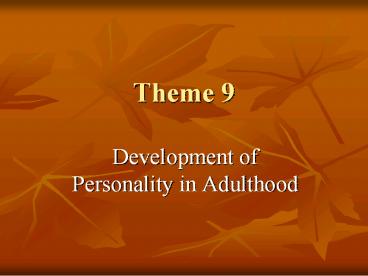Theme 9 - PowerPoint PPT Presentation
Title: Theme 9
1
Theme 9
- Development of Personality in Adulthood
2
- Do Our Personalities Change or Remain Stable
During Adulthood and Old Age? - Models of features Continuity
- Models of Discontinuity
- Development of I
- Models of life histories
3
Models of Features
- Kansas City Study (Neugarten)
- Stability in lifestyle, attitudes and emotions
- Personas dominance declines beginning at 50
years old - Theory of disconnection
- Tendency towards androgyny
- Strong paternal tendency in early adulthood
(Gutman 1987) - Androginy depends on cultural factors
4
Modelos de rasgos
- Baltimore Study (Costa MacCrae)
- High stability has been found in the big five
personality traits - Neuroticism (emotional instability)
- Extroversion - Introversion
- Conscientiousness
- Openness to experience
- Agreeableness
5
Emotional Instability and Age
6
Results of Studies Focused on Big Five Traits
- Transverse studies
- Neuroticism
- Extroversion
- Openness to experience
- Agreeableness
- Conscientiousness
- Longitudinal Studies
- Neuroticism
- Extroversion
- Openness to experience
- ? Agreeableness
- ? Conscientiousness
Related to life events
7
Models of Development of I
- Models that emphasize goals and objectives as
directing our behavior throughout life - The I as essence self-conception
- The I as action adaptation and self-regulation
8
The I as content Self-Conception
- Criteria
- Continuity
- Discriminative Relevance
- Biographical significance
- Diverse Content
- Many Dimensions
- The self conception does not worsen
- Negative affect decreases, as does positive
affect - A Paradox of Aging?
Posible Is Sense of Control Self-esteem
9
Hedonic Wellbeing, Happiness, and Age
Stability in hedonic wellbeing decline in
eudaimonic wellbeing
10
I as a Process Self-regulation and Adaptation
- Processes which regulate personal resources
decide lifes trajectory - Continuity and positive valuation of
self-conception are possible
11
J. Brandtstädter and the Theory of the Action of
Self
- We look for coherence between our present
self-conception and our goals - Two fundamental mechanisms
- Assimilation and Accommodation
Importance
Perception of control
Paliative significance
12
Development of I and Aging
- Assimilation and accommodation during aging
maintain levels of wellbeing - Assimilation declines with age
- Accommodation augments with age
13
Assimilation, Accommodation and Continuity of I
Throughout the Life Cycle
- Strategies of Assimilation
- Compensative activities External influences,
alternative activities - Strategies of accommodation
- Change in the standards of comparison
- Changes in reference groups
- Pessimistic vision of normal aging
- Change in the vision of personal trajectory
14
Assimilation, Accommodation, Regulation of the
Loss and Reorganization of Self-Conception
- Strategies of Accommodation
- Reassessment of goals Tamping of ideals
- Older people are more satisfied with their roles
and activities than younger people. - Substitution of some goals for others
- More realistic goals
- Changes in the priorities of life domains
health and physical environment.
15
Assimilation, Accommodation, and Growth of I
- Model of stages Erikson
- Intimacy vs. Isolation (6th stage) 20-35 años
- Emotional compromise or the achievement of
intimacy - Generative vs. Stationary (7th stage) 35-60
- The search for transcendence
- Not limited to the adult years
- Integrity vs. Desperation (8th stage) 60-
- Preparing to die, evaluating ones lifes
trajectory
16
Generativity and Age
17
Assimilation, Accommodation, and the Growth of I
- Gerotranscendence
- A quality that some people achieve in the last
decades of their lives - Connected to concepts like interiority, wisdom,
and integrity - Three Dimensions
- Cosmic Dimension
- Dimension of Self
- Social Dimension
18
Levinsons Model of Stages
- Empirical study of 40 middle aged men (The
seasons of a Mans Life, 1978) - Focus on mid-life crisis
- Meticulous interviews about family life, work,
meaningful relationships, compromises, etc. - Structure of life
- Follow-up study with female subjects
19
Levinsons Model of Stages
Changes in the structure of ones life
20
Mid-Life Crisis
- Occurs in many adults during some part of middle
age - Can last 2-5 years
- Involves changes in friends, family and work
- Subjects display depressive and
addictive symptoms renewed
focus on physical self
21
Models of Life History
- A person looks to narrate his own history in
order to understand himself, those around him,
and project himself into the future. - This process allows an individual to better grasp
lifes events and the transitions that provoke
changes in our persona provides a sense of
individuality. - It facilitates normative transitions
- There is a tendency to maintain a positive life
history
22
Models of Life History
- Provides support fundamental to our identity
- Directive Function
- Social Function
23
Some Concepts
- Reminiscence
- Making memories of the past
- Life Reflection
- Source of growth
- Not of daily life but decisive moments
- Revision of life
- Evaluative and therapeutic
- Necessary?
24
Some Concepts
- Continuity or Stability
- Evolutionary Transitions
- Turning Points
- Chance Encounters (Bandura)
- Beginning of the accentuation of psychological
characteristics

